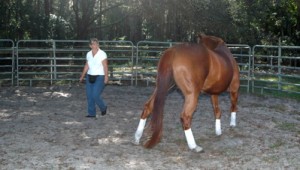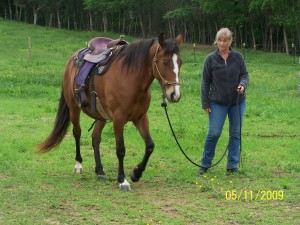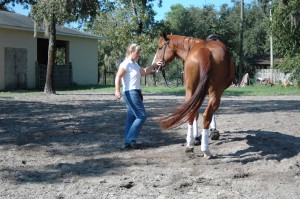I get asked this question a lot: What is this clicker training business and what could it possibly have to do me? My goal in this article is to dispel some of the more common myths about clicker training that have emerged over the last several years as the method has increased in popularity among horse owners.

Once the horse understands the clicker you can use it for liberty work in the round pen. Photo by Cynthia Mallard.
Unfortunately, at the moment clicker training still conjures up visions of silly pet tricks or dolphin training in the minds of many people. As such many serious riders take exception to the idea that clicker training could have any legitimate place in horse training. In fact, here are some actual objections that I have encountered in my discussions with horse people about clicker training. I’ll respond to each one in turn. Since I’m a dressage rider myself these objections usually come up in the context of dressage but really it could be any discipline.
Myth 1: People who employ clicker training in conjunction with dressage training are looking for a quick fix to problems that should be resolved by learning to ride better.
Reality: If only it were that easy! There are no quick fixes, no short cuts. We all need to ride better and that is simply a given. In order to use clicker training effectively you will need to add study of it to your existing education efforts. Some may think that this is a “side road” or a distraction that only wastes valuable time. But I have to disagree strongly with this sentiment. Here is why.
It is just not enough to be able to ride well. There is a big difference between the ‘good rider’ and the ‘great horseman’. The road from rider to horseman involves a lot more knowledge than can be gained just by taking riding lessons with your favorite big name clinician. Lessons and dressage instruction is important but if you are really serious about dressage you will make it your business to learn everything you can about horses and training. Doing some clicker training is one very powerful way to learn about how to train. You simply can’t have too many training skills!
Myth 2: Horses-unlike dolphins-do not normally communicate via clicking sounds and therefore clicker training can not be used successfully with horses.
Reality: Although it is true that horses do not communicate with clicks this fact is not a relevant factor when it comes to clicker training. After all dolphins are actually trained with a whistle! The fact is, any signal that can be reproduced reliably and consistently can be used as the “click”. For example, a buzz, a bell, a whistle, a touch, a flash of light or even a word can work.
What is important about the click is not the signal itself but the job it is intended to do. Its purpose is to “mark” (meaning highlight or point to) desired behavior for reward. The laws of learning tell us that ‘behavior that is rewarded will tend to increase in frequency’. So anything that gets marked and rewarded will start to occur more frequently. If you choose to mark, say, energetic forward movement you will get more energetic forward movement. Once you are getting the forward movement you can connect it to your leg aids. You can use the same concept for any of a number of ideas you want to make clear to the horse.

Clicker training can enhance ground work and longeing.
Myth 3: The click of a clicker can not possibly replace the full symphony of aids which is dressage riding.
Reality: Of course not and it is not supposed to. See above. The click is intended to mark performance you want to reward. You are not going to, say, click once for shoulder in and twice for half pass. Nor will you touch the horse’s right ear for right shoulder in. Or any other such silliness. The aids for shoulder in are still the aids for shoulder in. But, really, this is jumping way ahead. By the time you have reached the “symphony of aids” stage you are already deep into the horse’s training and long past the those days of clicking for the thought of looking at a cone.
If you had been using clicker training it would have been started well before this point and used to help lay the foundation that leads to that harmonious symphony. People who are using clicker training as part of their dressage training use it to help support the early learning process so that there can be a more harmonious experience down the road.
Many people seem to think that dressage training is limited to the part that occurs while riding. And therefore all one needs in order to train a horse is to ‘ride better’. While we all do need to ride better we all also need to extend our education to all aspects of training-both on the ground and under saddle. An important part of all training endeavors is understanding how the horse’s actions are influenced by reinforcement and punishment. There is no better way to develop oneself in this area than by clicker training your horse.
Myth 4: Well if clicker training is a reward, like saying “good boy”, and since I already praise my horse then clicker training is redundant and unnecessary.
Reality: It is true that the phrase “good boy” (and other praise words and phrases) are considered Conditioned Reinforcers just as the click of the clicker is a conditioned reinforcer. By conditioned we mean that the horse had to learn it stood for “something good”. It is not something good all by itself, like food is something good, or a nice rubdown is something good. These are considered primary reinforcers-the ‘real’ reward. The click is just a ‘stand in’ to buy time till you get to the real reward. Now if you were to connect “good boy” often enough with tidbits of food or rubdowns you could condition the horse to feel warm and fuzzy when you say “good boy”. Which is basically how praise works.
Many people do praise their horses. This is a nice thing to do but most people don’t use praise as part of a their larger reinforcement strategy. In fact, many people don’t seem to have a larger reinforcement strategy at all. There may be praising occurring but it doesn’t seem to correlate with specific advancements in learning or performance. For these horses this praise business is just so much background noise. I call it the “halo” effect. It might conjure up good feelings but in a generic sense.
What if the positive reinforcement (praise/rewards) were strategically applied to the training? More like a “laser” rather than a halo? Well that would be clicker training. Clicker training is based on these simple premises:
o Behavior that is rewarded will tend to increase in frequency.
o Primary reinforcers (pleasurable things like food or rubbing) can be linked to a marker signal (the click).
o Desired behaviors can be captured with the marker signal. Desired behaviors may include moving forward, stopping, turning or anything else you want to get the horse to do. Once basics are under way the savvy trainer may then click qualities of performance like stretching, or bending, or lifting the base of the neck.
o Behavior that is so marked or captured will tend to increase in frequency.
o Behavior that is occurring on a regular basis can be associated with a signal from the trainer (such as certain pressures from the leg, changes in body weight distribution, changes in body position, changes in rein contact) so that the behavior can be requested at will. These would be the basic aids.
Once the basic aids are understood they can be combined in the traditional ways in order to construct any movement desired.
In order to make this whole process work it needs to be started before you climb into the saddle! Once you are in the saddle your rate of reinforcement with the clicker, which had been very high during the initial training period will tend to taper off after the first few lessons. Until finally you may only click for exceptional moments a handful of times during a lesson.
Myth 5: Clicker training is only good for tricks and trick training is an insult to the horse’s dignity.
Reality: Insult is in the eye of the beholder. I won’t try to convince you that tricks are not an insult to any one’s dignity. But I’ll say this. Tricks should be fun. And, my own experience with horses is that they enjoy a “good laugh” now and again like the rest of us. So, train a ‘trick’ or two if for no other reason than to learn how to set a goal, break it down and figure out a way to train it.
However all that left aside hopefully by now you can see that there is a very serious side to clicker training and it most definitely can be used as part of your horse’s “serious” dressage training. Don’t be surprised though when, as a result of clicker training, your dressage horse starts to discover that even dressage can be more fun.

For work in hand the click can highlight those moments you would like the horse to seek out again. Photo by Cynthia Mallard.
Myth 6: You would not be allowed to carry a clicker or make noises during a dressage test so clicker training can not work for dressage.
Reality: It is true that you wouldn’t be allowed to carrying a clicker in a dressage test. But then there certain championship tests in which you are not allowed to carry a whip either. However this doesn’t keep people from training with a whip before and after the test.
So if you had been using clicker training as part of your training approach, the assumption would be that by the time you get to the testing stage you would be showing the finished results of your training. At least for the level you are testing at. In other words, the time for clicking little steps would be past. Once the horse understands what is expected of him he will continue to do it with only minimal reinforcement which can be done when you leave the testing arena.
Most of these myths are just a matter of misunderstanding about what clicker training is and how it fits in. What more dressage riders are discovering is that not only is there no conflict (between clicker training and dressage) but learning about clicker training has made it possible for them to tap into that elusive relaxed and playful approach to training that the old masters spoke about but they were unable to figure out how they did it.
I will sum up with a quote from The Complete Training of Horse and Rider by Alois Podhajsky (emphasis is mine):
“After a successful exercise, it is effective to walk for a while on a loose rein. The horse will soon accept this gesture from the rider-a break from the work-as a reward, and try to merit a repetition. It is interesting to note that Xenophon specified as a reward that the rider should, there and then, dismount and lead his horse to the stable, not ride him back. Food or sugar after as successful exercise is another way of showing appreciation, provided it is given immediately. From the manner in which rewards and punishments are administered, interesting conclusions can be drawn as to the character and mind of the rider.”

Hi! I can’t tell you how happy this article made me! My trainer and I combine clicker training with ‘normal’ dressage training as a matter of our simple training philosophy. Your article spoke to every conversation we have ever had about the benefits of clicker training and dressage and the myths/misconceptions/reputations of clicker training out there!
In particular I cannot agree/relate more with your dissection of ‘Myths 1 & 2’! Clicker training has taught me more feel and more correct riding than I have ever learnt from conventional training! The whole process of small steps and their building blocks teaches correctness and rider awareness like nothing else… Of course outsiders think its a quick fix – it can be so quick when the horses understanding and enjoyment for the clicker is established because you simply ARE riding better and your work with your horse is correct! Secondly, with regard to Myth 2, if more people bothered to read and understand the SCIENCE behind operant conditioning they would understand clicker training properly! It is no mumbo-jumbo, it is one of the oldest principles of the psychology of learning!
Once more people opened themselves to the method and truly tried to understand it, particularly points 1 & 2, all the subsequent myths fall away on their own.
Thankyou for writing such a great article, it is so nice to know there are others out there who understand just how well clicker training can go hand in hand with modern dressage training!!
Corinne, Australia